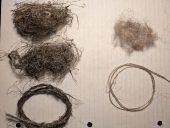
 21
21











 5
5
















Trying to achieve self-reliance on a tiny suburban plot: http://gardenofgaladriel.blogspot.com
 9
9











 2
2




URL 2023-08-09 : https://nettlecraft.com/How-to-Root-Ret-Nettles




We really don't know how much we don't know.
 7
7











 11
11











 2
2




 10
10




Practice being a Maker without first being a Consumer whenever possible...
 6
6




We really don't know how much we don't know.
 4
4





 9
9




 2
2




Best luck: satisfaction
Greatest curse, greed
 6
6











 1
1




Living in Anjou , France,
For the many not for the few
http://www.permies.com/t/80/31583/projects/Permie-Pennies-France#330873
 5
5











 9
9















Best luck: satisfaction
Greatest curse, greed
 1
1




raven ranson wrote:It looks like this method creates a fibre that is a lot like cotton. Short, fine fibres.
I like this. They look very soft.
And yet, it conflicts with my previous knowledge which is that medieval Europeans processed it "like flax" to produce a fibre indistinguishable from flax except by microscope. This just goes to show that there are many right ways to get fibre from nettles.
"Also, just as you want men to do to you, do the same way to them" (Luke 6:31)
 2
2





Using a proprietary extraction process, we produce a lustrous, long fiber that is spun by commercial mills to produce beautiful, unusual yarns for use in luxury interiors and high-end apparel.


















 2
2















 3
3











 1
1




Maureen Atsali
Wrong Way Farm - Kenya
 1
1




First question, how to harvest them? Should I go by size? Cut them at the base, or pull it by roots?
have you ever known anyone to have a severe reaction to nettles? More than stinging, temp rash, and discomfort?







 3
3




![Filename: nettle-fibre.jpg
Description: harvesting nettle fibre for yarn [Thumbnail for nettle-fibre.jpg]](/t/50840/a/50865/nettle-fibre.jpg)







 1
1















Best luck: satisfaction
Greatest curse, greed




Thekla McDaniels wrote:
About the boiling in wood ash slurry, I wonder if soaking in wood ash slurry would suffice (perhaps for a little longer). The lye in the wood ash will become active without addition of heat, if it is the caustic action of the lye you are wanting.







 1
1
































raven ranson wrote:I hear some of you say that you have nettles. I suspect that there is a lot of regional variation in how nettles are harvested because there is so much regional variation in the different types of nettles. ...
"Also, just as you want men to do to you, do the same way to them" (Luke 6:31)











 1
1




When it is obvious that goals cannot be reach, don't adjust the goals, adjust the action steps. Confucius
 3
3









Hans Albert Quistorff, LMT projects on permies Hans Massage Qberry Farm magnet therapy gmail hquistorff

| I agree. Here's the link: http://stoves2.com |








